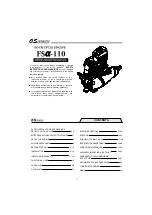
PRODUCT INFORMATION
INDEX
DATE
Dep. 2
IC-G-D-60-003e
D
May 2016
REVIEW OF COMPLIANCE WITH EUROPEAN MACHINERY
SAFETY REGULATIONS AND "CE" MARK
5/7
4.10. BLOW-BY GASES
Because it is impossible to have the combustion chamber completely sealed, combustion gases always
accumulate in the crankcase and can give rise to oil splashing outside due to overpressure in the crankcase. To
prevent this occurrence, all the engines come complete with an explosion relief valve to expel those gases,
which are fed back after filtering into the engine intake system on environmental protection grounds.
4.11. EXHAUST FUMES
The emission of exhaust fumes is intrinsic to the engine’s function and is thus inevitable. There are clear and
specific instructions for installing exhaust gas piping to eliminate the risk of contaminating the engine room.
Those instructions specify the requisites for the exhaust piping layout, how to calculate the pipe diameters,
standards for the placement of expansion joints, etc.
4.12. MAINTENANCE
Maintenance tasks must be undertaken with the machine idle. The maintenance, adjustment, lubrication and
upkeep points lie outside dangerous areas. Staff can work safely and at ease and the reasons for their
intervention are limited.
4.13. INFORMATION
Product information necessary for using the equipment is clear, concise and easy to understand. The machines
include alarm systems that report any malfunction of the machine and warn exposed persons of possible risks.
There are signalling devices (dial gauges, control panels, etc) on the equipment as well as warning signs
informing of potential non-evident persistent hazards through icons that everybody understands.
All engines are delivered with a minimum of safety devices and operational controls and although their primary
function may not be to protect operators, they do protect them indirectly by preventing malfunctions or
inadequate operation.
The following information is legibly and indelibly available on each machine: nameplate (manufacturer's name
and address, model, serial number, year of manufacture, power, fuel gas quality and pressure requirements),
and specific “CE” mark tag. The product information also contains all the necessary instructions for the safe
operation of the machine.
On the non-moving parts of the engine there are strong lugs for the safe handling of the engine with
conventional lifting equipment. The product information also clearly states the engine’s weights needed for tis
suitable transport.
4.14. INSTALLATION, OPERATION AND MAINTENANCE INSTRUCTION MANUALS
Each machine has its instruction manual containing a reminder of the data required for the marking, except the
serial number, as well as the instructions for easy maintenance, conditions of intended use, instructions for safe
commissioning, operation, handling (including information about the machine’s weight), installation, assembly,
disassembly, adjustment, maintenance (preventive and corrective), and counter-indications.
Kohler
has prepared an instruction manual in Spanish, English, French, German
and Italian. This manual must be kept close to the machine, when put into service. The mechanic's handbook,
intended for specialist staff who source from the manufacturer, is available in English or Spanish. According to
the standing regulations, to use the “CE” mark, it is compulsory to have the engine instruction manuals available
in the official language of the member state in which the engine operates. Fulfilment of these regulations will be
achieved by translating the current Installation, Operation and Maintenance Instruction Manuals in pace with the
sales of our engines to the various countries in the European Union.
1.13
O&M_2.002211.810_A_10_2016
















































